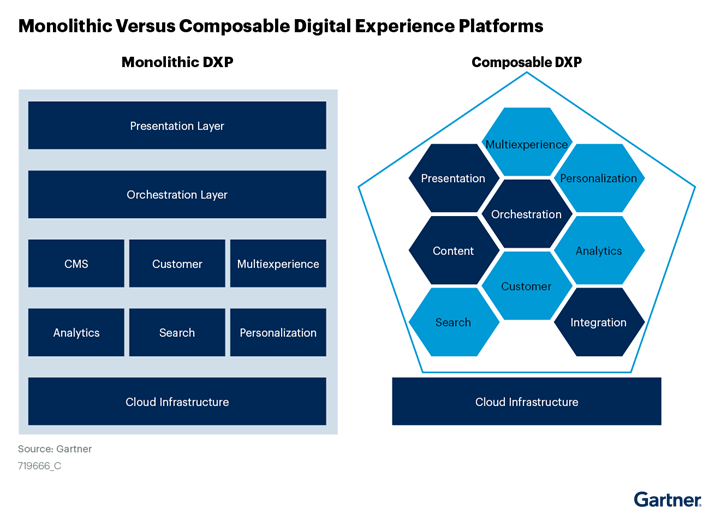Remember those matching furniture sets that were all the rage in the mid-90s but have since fallen out of favor? Buyers no longer want one-size-fits-all solutions from a single vendor—and the same goes for traditional e-commerce platforms.
These legacy applications offered basic capabilities for anyone to set up and run a low-code/no-code e-commerce website. While well-suited for the first e-commerce wave starting with Amazon’s founding in 1994, these platforms were not built for the addition of new digital touch points such as mobile devices, IoT (Internet of Things), and social media.
With e-commerce fast becoming the predominant conduit for businesses to engage and convert prospects—by 2023, online sales will represent 22% of all global retail sales—today’s businesses are breaking away from rigid technology stacks that lack scalability, API integrations, and omnichannel support.
The new solution? Composable commerce—a type of agile software architecture that allows businesses to integrate best-of-breed applications from different vendors into a seamless technology stack.
What is composable commerce?
Composable commerce is an approach to e-commerce that involves stacking disparate microservices (small, independent services that communicate over well-defined APIs) to achieve greater flexibility. These microservices are also known as Packaged Business Components (PBCs).
They’re different from regular software applications because instead of offering, for example, a complete mobile payment system like PayPal, a PBC might offer a shopping cart microservice that deducts items from inventory and lets customers complete the checkout process, while a separate PBC handles order fulfillment. Think of a PBC as a building block within a larger software application. Rather than sharing a unified codebase, as with monolithic applications, each PBC holds its own data and business logic.

Basically, composable commerce architecture leverages modern technologies like MACH (Microservices, API, Cloud, Headless) and JAMstack (Javascript, APIs, and Markup) to enable businesses to integrate and combine these building blocks in virtually limitless ways. It includes pre-built solutions, integrations, and reference libraries.
The importance of customization for digital maturity
Why does this level of customizability matter? Let’s say, for example, that your business sells concert tickets. When a customer adds an item to their cart, you want to impose a time limit for completing the purchase so that other shoppers aren’t barred from purchasing tickets if someone abandons their cart. If your payment processing software doesn’t offer that feature, you’re stuck.
By combining piecemeal microservices rather than trying to shoehorn business requirements within the limitations of an out-of-the-box e-commerce platform, businesses can offer better CX personalization and even improve product discoverability.
Think about it: in order for your products to be searchable, you need multiple moving parts: a digital experience platform (DXP), SEO, visual configuration, custom storefronts—not to mention providing an omnichannel experience across your website, social media channels, voice search, and more. No single e-commerce platform offers all of the capabilities needed.
According to Elastic Path’s State of Composable Commerce report, 95% of e-commerce practitioners surveyed believe composable commerce is the best approach businesses should take.
Benefits of composable commerce
Today’s e-commerce businesses are differentiated not so much by the products they sell but by the type of online shopping experience they offer. For example, plant-based cereal brand Off-Limits created a vending machine-like buying experience that led shoppers to a gamified checkout to make buying cereal fun. Meanwhile, Allbird’s mobile app lets customers try shoes on virtually using AR. Here are some reasons why composable commerce benefits brands who want to push the envelope.
- Allows businesses to be vendor-agnostic
Rather than being locked into one vendor’s solution, businesses can make changes to strategy and even experiment with new business models without relying heavily on IT staff.
- Modular architecture
Supports agile delivery, faster time to market, and improved experiences across all touchpoints.
- Open ecosystem
Empower brands to assemble best-of-breed solutions using third-party applications, in-house solutions, and custom-built apps.
- Cost control
Reduce operational costs by choosing only the features and vendors you need. - Gives businesses a competitive edge
In a “build vs buy” landscape, businesses that rely on out-of-the-box solutions will fall behind peers who are building their own custom applications. Gartner predicts that by 2023, “organizations that have adopted a composable commerce approach will outpace the competition by 80% in speed of new feature implementation.”
Disadvantages of composable commerce
While composable commerce offers greater flexibility, organizations need a high level of digital maturity to implement it.
- Managing multiple vendors
Each time you implement a new microservice, you’ll have to negotiate purchase agreements, review terms and conditions, and integrate it with your existing technology stack. Also, beware that each vendor has its own service level agreement; some are better than others at handling traffic spikes and other contingencies. - Creating an interface to integrate microservices
Connecting microservices from different vendors requires businesses to build a cohesive user interface on top of these components—a process that is time-consuming and often unclear.“Think of microservices like LEGO blocks without an instruction manual to piece them together to build that creation you had perfectly envisioned,” Jimmy Duvall, chief product officer at BigCommerce, wrote in an article on Forbes. - Fear of the unknown with your internal teams
Introducing more variables to your e-commerce stack makes it more complicated for teams to learn how to use the software or understand its capabilities—especially during implementation.
Why composable commerce? Why now?
The death of third-party cookies has forced brands to rethink personalization. A Shopify survey found that 42% of brands plan to offer their customers personalized product recommendations through tools like quizzes, custom mobile apps, and first-party or third-party behavioral data.
Customer channels are becoming more numerous and fragmented. Consequently, brands need tools that will allow them to create an omnichannel experience across all customer touchpoints.
- Retailers are experimenting with new channels like voice shopping, connected TVs, and messaging apps.
- Direct-to-consumer (DTC) brands are doubling down on marketplaces as a way to get new eyes on their products.
- Brands are creating more ways for customers to interact with them (eg: recipe sites, community hubs, chat rooms, and IRL experiences).
- Demands for AI-assisted upselling and cross-selling, which can customize a website for every customer by predicting shopping habits based on browsing and purchase history.
While traditional e-commerce platforms would gather behavioral data, categorize users according to a set of predefined personas, and serve each cohort with “personalized” content, today’s modern platforms are built to personalize for an audience of one.
Composable Commerce for Enhanced User Experience
When it comes to e-commerce functionality, user experience stands at the forefront of successful e-commerce. Your site’s front-end presentation empowers brands to meet and exceed customer expectations by tailoring every touchpoint in the customer journey. By adopting a modular approach, businesses can craft a unique and intuitive customer experience, ensuring seamless interactions and enhanced satisfaction.
Guided Selling Assistants
The aim of marketing is to know and understand the customer so well the product or service fits him and sells itself. – Peter Drucker
Guided selling assistants act as virtual salespeople, assisting customers throughout their journey. They provide real-time advice and insights, ensuring customers make informed decisions that align with their needs.
3D Product Configurations
Allow customers the flexibility to configure products in 3D as per their requirements. Whether it’s selecting features, colors, or other attributes, a personalized approach ensures a satisfying and memorable customer journey.
Intelligent Search
You can’t find what you don’t know is missing. – Gene Kim
Enhance the user experience with intelligent search capabilities. Customers can quickly find what they’re looking for thanks to smarter algorithms that anticipate needs and preferences, streamlining the shopping experience.
Product Quizzes
Engage customers with interactive product quizzes. These tools can decipher customer needs and preferences, ensuring recommendations that align perfectly with individual expectations and enhancing the overall user experience.
CPQ (Configure, Price, Quote)
You don’t close a sale; you open a relationship. – Patricia Fripp
In the world of B2B or complex B2C sales, CPQ tools ensure that customers can tailor products or services to their specific requirements. This personal touch meets and often surpasses customer expectations, fostering a superior user experience.
Composable Commerce vs. Headless Commerce
When diving into modern e-commerce solutions, two terms frequently emerge: Headless Commerce and Composable Commerce. While both aim to offer businesses greater flexibility and agility in their digital offerings, they approach this goal with nuanced differences. Headless commerce focuses on detaching the user interface from core business processes, whereas Composable Commerce takes modularity to the next level, enabling brands to piece together distinct services for a tailored solution. Let’s delve deeper into these paradigms to understand their unique advantages.
Headless Commerce:
Headless commerce is a design paradigm where the front end (presentation layer) is separated from the back end (business logic and data layers) of an e-commerce system. By decoupling these elements, brands gain the flexibility to use any frontend technology, thus optimizing the presentation of content across various channels and touchpoints. The connection between the front end and the back end in this system is typically maintained via APIs.
Composable Commerce:
Composable commerce can be viewed as an evolution of headless commerce. It goes beyond just the separation of frontend and backend. Composable commerce encourages businesses to use best-of-breed microservices, APIs, and individual components to build their custom e-commerce solution. Instead of relying on a one-size-fits-all system, brands can handpick and combine different services, such as cart functionalities, payment systems, and product management tools, from various vendors. This modular approach provides unparalleled flexibility and allows businesses to rapidly adapt to market changes or unique needs.
What is the difference between modular and composable commerce?
Even if composable commerce is new to you, you may have heard of its close relative: modular commerce. Both are examples of headless commerce—a type of software architecture where the front end is decoupled from the backend. This separation means the front end can be updated without interfering with the back end.
Modular commerce took headless commerce a step further by separating backend services (eg: file storage, databases, APIs) from each other, allowing them to be offered individually rather than purchasing a prepackaged system. Composable commerce builds on that by allowing retailers to gain complete end-to-end control over both back-end and front-end, choosing and implementing only the services they need when needed.
Think of modular commerce as having the ability to combine bricks from different LEGO sets. By comparison, composable commerce is analogous to combining bricks from any toy brand in any configuration you desire.
Composable Commerce Solutions
Composable Commerce is a pioneering approach to building tailored e-commerce solutions that places modularity at its core. Unlike traditional commerce systems, which often present rigid and monolithic structures, Composable Commerce leverages a headless architecture, decoupling the frontend user interface from backend functionalities. This allows businesses to assemble specific components that align with their unique needs, thereby delivering enhanced e-commerce experiences.
If you’re at the onset of your e-commerce journey or considering a shift in your current model, it’s crucial to assess your brand’s specific requirements. Will a headless approach suffice, or do the benefits of a composable strategy better suit your vision for growth?
Remember, the ultimate goal is to enhance the customer experience. Whether through Headless or Composable Commerce, your chosen path should resonate with your brand’s ethos and customer expectations.
Enterprise AI Within Your Composable Commerce Platform
No matter which platform you choose for your composable commerce site, in the ever-evolving environment of ecommerce, personalized experiences stand out. Zoovu delivers the distinct solutions you need to shape your digital storefront and echo each customer’s interests — even without third-party cookies.
By seamlessly integrating Zoovu with your composable commerce platform, you will create industry-leading customer engagement experiences and set the stage for transformative growth for your business. Partner with Zoovu, and together, let’s transition your e-commerce vision into an exceptional reality.
